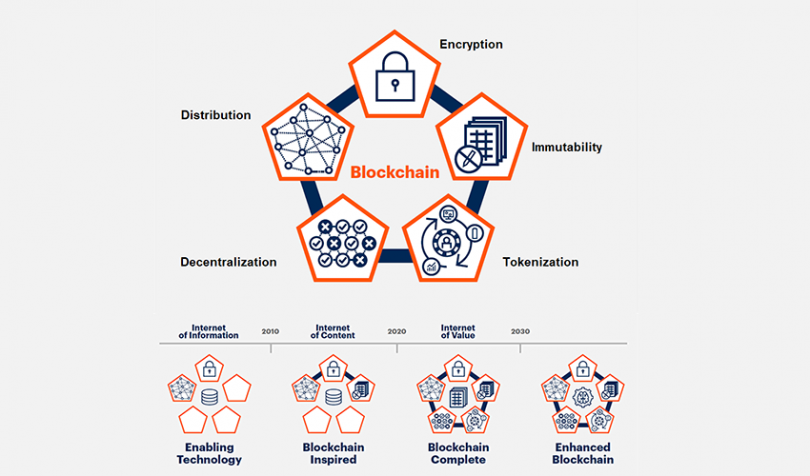Yesterday, Gartner published the ‘Blockchain Spectrum’, its prediction for the evolution of blockchain in four phases. Today, we are in the latter part of the second phase, ‘blockchain-inspired’, which has yet to unlock the technology’s full potential. The leading advisory firm emphasizes its business value but warns of possible missteps made by firms using an unsuitable strategy.
“The evolution of blockchain cannot be ignored,” said Gartner’s VP of research David Furlonger. He and fellow research VP Christophe Uzureau authored the book, ‘The Real Business of Blockchain: How Leaders Can Create Value in a New Digital Age’, which they presented yesterday. The blockchain spectrum is utilized as an analytical tool.
Broadly, Gartner defines blockchain as having five elements (pictured): encryption, immutability, tokenization, decentralization, and distribution. According to the firm’s analysis, enterprise won’t make use of all five until the 2020s, when the third phase begins. These spectrum phases are:
- Blockchain-enabling: the technologies that formed the foundation; cryptography and peer-to-peer networks, for example. This phase ran until around 2012.
- Blockchain-inspired: the current phase, where pilots and proofs of concepts (PoCs) are being explored and sometimes deployed.
- Blockchain-complete: the next phase, not slated to start until around 2023. Then, all five elements will be integrated into enterprise solutions.
- Enhanced blockchain: finally, after 2025, the internet of things (IoT) and self-sovereign identity (SSI) will converge with blockchain solutions. This will allow automation and transactions on a vast scale.
So, Gartner believes that enterprises are currently dipping their toes in blockchain, but are missing out on the decentralization and tokenization elements. Indeed, these two are perhaps the riskiest elements.
We see that many private and permissioned, rather than entirely decentralized, blockchains are used for enterprise applications. But, with viable concerns about public blockchains, is this a bad thing?
Furlonger thinks, in the long term, that it could be: “Blockchain-complete solutions will begin to gain traction in about three years. Only slightly further out lies a future business and societal environment that includes IoT and AI in which autonomous and intelligent things own assets and trade value.”
“Business leaders who fail to do scenario planning or experiment with the technology, and delay consideration of the two fundamental blockchain components, decentralization and tokenization, risk being unable to adapt when blockchain matures,” he continued.
Uzureau agreed: “Though not immediate, the proliferation of blockchain-complete solutions will push organizations to explore new ways of operating with greater degrees of decentralization than they have now.”
Gartner has published multiple reports on blockchain, the most recent surprisingly singled out CRM sales as an application. The firm predicts 60% of CIOs will adopt blockchain in three years, but the financial services industry may lag behind.






